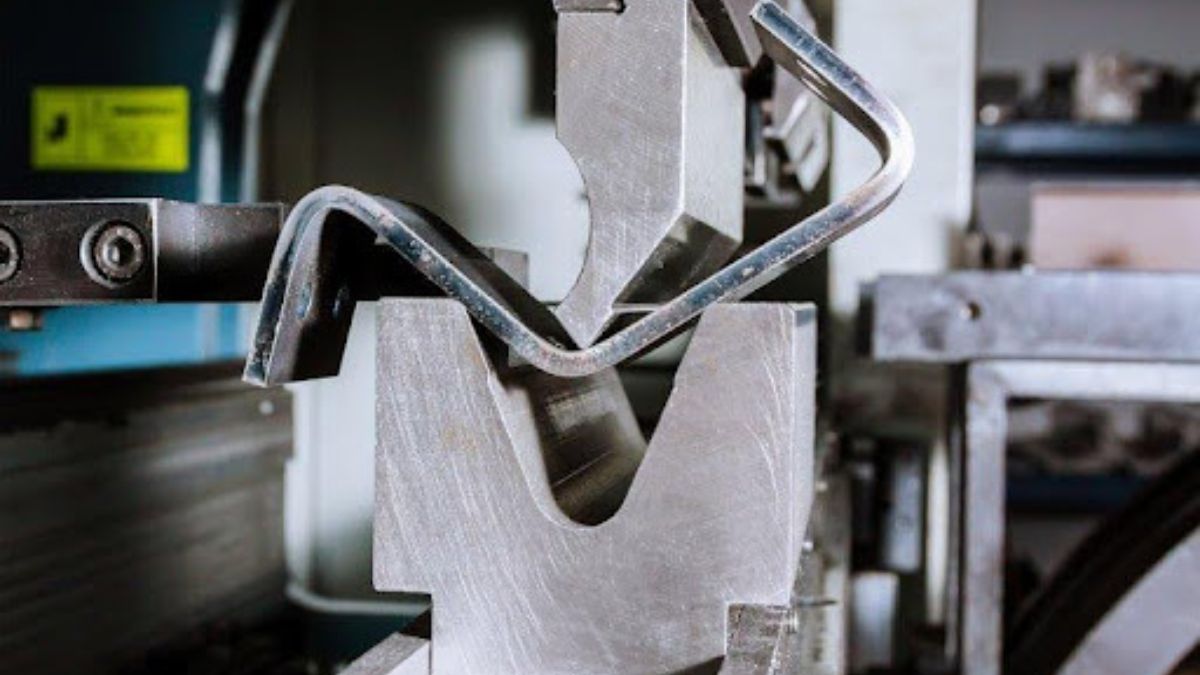TECHNOLOGY
An Informative Guide to Bending Sheet Metal

Sheet metal bending is one of the effective fabrication techniques product designers utilize to produce reliable and high-quality metal components. This metal forming technique is suitable for low production runs, which might require thin metal to make components when casting fails to provide the desired outcomes.
This article provides an in-depth discussion of everything you need to know about bending sheet metal and a step-wise guide to the process. You will find out the standard sheet metal bending techniques, applications, and helpful considerations for effective sheet metal bending!
Overview of Sheet Metal Bending
Sheet metal bending (also known as edging, forming, flanging, die bending, or press braking) is a standard metal forming process that involves applying a force to a metal sheet with a press brake to create a radius. Manufacturers and product designers often use sheet metal bending techniques to create components like fridges, electronic casings, vehicle body panels, and brackets.
Product engineers bend metal sheets once or multiple times to achieve the final geometry. However, manufacturers often use sheet metal of varying thickness. The minimum thickness of sheet metal suitable for bending is about 127 mm, while the material type and thickness frequently determine the maximum thickness. However, sheet steel is not usually more than 6 mm thick. Hence, the bend radius should be the same or greater than the material’s thickness.
A Stepwise Guide to Bending Sheet Metal

While a press brake is the most commonly used tool for bending sheet metal, it is mechanical and completely manual. Machinists use various CNC (computer numerically controlled) machines with a hydraulic system. Although they have the same working principle, the operator’s interaction differs. We’ll explore steps on how to use a CNC press brake machine to bend sheet metal below:
Step 1: Evaluate the Design Parameters
Ensure you calculate the design parameters such as required force, bend line (the point where the force is applied), and the order of bends (when you need to bend multiple times). Additionally, you have to determine the required die to create the bends.
Step 2: Prepare the Press Brake
Here, you must program the CNC press brake machine with the calculated information, preparing it for the bending operation. As such, the machine understands the required force to exert on the metal sheet to form the right bend and the required order for the bends. In addition, the right tool and die must be attached to the press and brake to make the bend.
Step 3: Align the Workpiece
Ensure the sheet metal is correctly aligned between the tool and die after the machine has been set up. Position the workpiece in the designated area and clamp it tightly to avoid deflection or inaccurate bending. The CNC machine will bend the sheet metal at the bend line once it begins operation.
Step 4: Engage the Press Brake
You have to engage the press brake for it to apply the force parameters programmed into the CNC press brake earlier in the process. Proceed to remove the part once the press brake has bent the sheet metal. Then, prepare for the next stage of production.
Step 5: Inspect and Make Adjustments
Inspect the workpiece carefully for any flaws or necessary adjustments after you have unclamped it. If the bend is inaccurate, you can make minor adjustments with a mallet or hammer. However, you may need to reposition the sheet in the brake and re-bend if the bend angle is slightly off,
Standard Sheet Metal Bending Techniques

Sheet metal bending involves deforming metal sheets along a straight axis using various techniques to achieve varying shapes and bend angles. Here are typical techniques for bending sheet metals to the desired angles:
V-bending
This widely used sheet metal bending technique employs a v-shaped die and a punch in bending sheet metals at preferred angles. The v-shaped punch presses the sheet metal workpiece into the v-shaped groove in the die, forming the metal sheet with different bend angles. For instance, you can make 90°, acute or obtuse angles based on the v-shaped punch and die angle.
U-bending
U-bending is a typical metal sheet bending technique that forms the sheet metal into a U-shape. It involves placing the sheet metal on the U-shaped die that creates two parallel bends with a flat section in between, then using a punch to press it down to force the metal into the U-shaped groove, forming a U-bend. This technique is ideal for making channels and enclosures for different applications.
Air Bending
Like the V-bending, air bending relies on a v-shaped punch and die to bend metals into preferred shapes. However, the punch in the air bending technique leaves space/air below the sheet instead of forcing sheet metal to the cavity’s bottom, allowing more bend angle control.
For instance, you can achieve bend angles ranging between 90° and 180° using the air bending methods if you have a 90° die and punch. Since less springback occurs in this metal bending technique, it provides a more accurate outcome. Springback is often avoided since it can lead to inaccurate bends.
Wipe Bending
This method lets you bend sheet metal into the desired geometry by holding the workpiece against a wipe die with a pressure pad. Then, the punch forces the metal sheet’s edge to extend beyond the die and pressure pad, making it bend over the die’s end.
The wipe bending method provides exceptional mechanical advantages, such as applying less force to achieve the preferred bends and bend angles. Nevertheless, this technique might be unsuitable for making obtuse bend angles because you might need sophisticated machinery capable of producing horizontal force.
Rotary Draw Bending
The rotary draw bending technique involves clamping the sheet metal to a rotary die and drawing around the die to produce a geometry whose radius meets the preferred bend radius. Product engineers typically utilize an internal supporting mandrel in this method to avoid wrinkling on the bent sheet metal’s wall.
The rotary draw bending technique provides extensive benefits compared to other sheet metal bending methods. One of the many benefits of the rotary draw method is that it doesn’t scratch the surface of the sheet metal and can bend metals into sharp corners with obtuse bend angles.
Bottoming
Bottoming bending is a variant of v-bending that mitigates the springback issue by pressing the workpiece down to the bottom of the die, making the workpiece touch the edge of the v- or u-shaped die. It applies additional force through the tip of the punch to deform the sheet metal in the bend region. Also, bottoming is similar to the air bending method because it offers a precise bend angle control.
Roll Bending
In roll bending, you can bend metal sheets into cones, tubes, rolls, and curved shapes. This forming method relies on rollers that feed the metal stock to the desired curvature. The roll bending technique allows you to bend metals into different cross-section profiles comprising various bending curves. It is mainly suited for producing very long sheet metal parts with 0.004 to 0.125 inches range and approximately 20 inches width.
For example, the roll bending machine can create common metal parts used in buildings for roofing, lighting, and HVAC applications such as shelving, panels, and tracks.
Helpful Tips to Consider When Bending Sheet Metal

Even though sheet metal bending types offer desirable outcomes, the process can become complicated if the technique is wrong. Hence, we will discuss helpful tips to ensure you create perfect bends on sheet metals below:
Pick the Right Material
Although different metals are compatible with sheet metal techniques, some are relatively more malleable than others. Hence, it would be best to be mindful of the use of heat and reduce any material cracking and weakening if necessary. Copper, mild steel, galvanized steel, stainless steel, and aluminum are typical materials that work best for sheet metal bends. Copper offers antimicrobial benefits, stainless steel, galvanized steel, and stainless steel exhibit good corrosion resistance and malleability.
Determine Bend Allowance
Bend allowance recompenses what happens to the workpiece when stretched and formed into the desired bend from a flat pattern. Since the metal bending process involves material pushing, pulling, or stretching, you would have to calculate the bend allowance for the sheet metal to derive reliable measurements to work with when you lay out a flat metal sheet. However, when calculating bend allowance, you must consider variables such as internal radius size and material thickness.
Protect the Sheet Metal’s Surface
Preventing the metal’s surface from scratches when bending is essential to attain a fine surface finish. You can use masking tape in any area that comes in contact with something hard. Also, wood blocks effectively protect the appearance of your metal when bending.
Prevent Sharp Internal Corners
When bending metal sheets to desired forms, avoid bending to a sharp internal corner because it can crack or weaken the metal. However, have a radius on your bending tool to mitigate this complication. Additionally, ensure the inside bend radius is the same as the thickness of the material you are bending.
Conclusion
Bending sheet metal is an integral fabrication process with a distinct edge over other manufacturing methods. It offers lower cost, high design flexibility, and increased output, providing functional components and structures for several applications. However, the application’s specific requirements, such as the type of metal, required shape, and production volume, will determine the ideal sheet metal technique for your project. Always work with a professional sheet metal fabricator to get the best results.
TECHNOLOGY
Modern Wire Management Solutions for Safer and More Efficient Workspaces

As reliance on electronic devices and network connectivity continues to grow in offices, classrooms, and industrial settings, the task of managing cabling systems assumes new significance. Without orderly and well-planned cabling, safety hazards, workplace inefficiencies, and increased maintenance costs can quickly arise. That’s why network cabling Nashville has become a crucial consideration for facilities striving to maintain high standards in safety and performance.
Proper cable and wire management is crucial for workspace design, as it impacts operations, safety, and employee well-being. It prevents issues such as slip-and-fall accidents, downtime, and electrical fires, while assisting IT teams with system upgrades. Innovative wire management solutions enhance aesthetics and functionality, adapting to sustainability goals and incorporating modern advancements for safer, cleaner workspaces.
The Importance of Effective Wire Management
Keeping cables and wires organized is more than just an organizational preference—it’s a workplace imperative. Tangled or exposed wiring presents serious tripping hazards and, if neglected, can result in injury or legal consequences for employers. Additionally, electrical faults or short circuits caused by poorly managed cables may damage valuable equipment or compromise entire IT infrastructures. Data from the Occupational Safety and Health Administration (OSHA) shows that slips, trips, and falls remain one of the leading causes of workplace injuries, many of which stem from cable clutter.
Routine maintenance is also streamlined when cables are appropriately organized and labeled. This vital yet straightforward measure enhances system reliability and reduces downtime during troubleshooting or upgrades, resulting in substantial time and cost savings. Even aesthetically, a neat, cable-free floor and desk environment communicates professionalism and can positively impact employee morale and productivity.
Innovative Cable Management Solutions
The evolution of cable management has introduced breakthrough solutions designed to address today’s dynamic workplace requirements. These innovations enable organizations to adapt swiftly to growth and change while ensuring that vital safety and efficiency standards are met.
- Wire Mesh Cable Trays: Versatile and easy to install, wire mesh cable trays support large volumes of network and power cables without obstructing airflow. Their flexibility is ideal for spaces that are likely to undergo frequent cable rerouting or expansion, as the open design allows for quick and hassle-free additions and changes.
- Under-Desk Cable Management: Modern workspaces often feature open layouts, which makes managing cables around desks and workstations critical. Under-desk trays and raceways can discreetly hide cords, keep floor space clear, and reduce the risks associated with chair wheels or foot traffic snagging cables.
- Smart Integration: The integration of IoT features and digital monitoring into cable management systems, such as occupancy sensors and automated power controls, is revolutionizing the field. Facility managers can optimize energy use and maintenance schedules, monitor power loads in real time, and enhance overall workplace safety and sustainability.
Modern organizations must remain vigilant as older cabling solutions may not meet new demands for flexibility, scalability, or digital integration. Embracing the latest tools and products allows workspaces to stay competitive while reaping the operational benefits of robust wire management practices.
Implementing Sustainable Practices
Sustainability isn’t just a buzzword in modern facilities management—it’s a foundational principle guiding design and operational decision-making. In the context of wire management, this means selecting eco-friendly, durable materials, such as recycled plastics and metals, for cable trays and raceways. Designing systems with future upgrades in mind also minimizes environmental impact, as organizations can avoid the need for wholesale replacement of cabling infrastructure.
Some manufacturers have begun offering modular trays and supports that can be quickly reconfigured for new technology rollouts, resulting in less waste and lower lifetime costs. Additionally, integrating smart controls that automatically reduce power during periods of inactivity enhances energy efficiency, contributing to broader sustainability objectives. The U.S. Environmental Protection Agency’s guidelines on green buildings provide more insights into sustainable materials management for office environments.
Conclusion
Adopting modern wire management solutions is crucial for organizations that prioritize safety, productivity, and sustainability. By leveraging innovative materials and intelligent systems, workspaces become not only more visually appealing but also inherently safer and more adaptable to change. Strategic cable management yields returns in operational efficiency, risk reduction, and readiness for future technology advances—making it a wise, forward-looking investment for every business.
TECHNOLOGY
Brats in Air Fryer: How This Simple Innovation Is Reshaping Modern Cooking and Leadership Thinking

In today’s rapidly evolving world, innovation is no longer measured solely by flashy gadgets or celebrity chefs. The most influential food trends are those that merge convenience with quality, reshaping how people cook, eat, and connect. One emerging example is the rise of brats in air fryer cooking—an approach that combines technology, tradition, and purpose.
This article explores how the humble bratwurst meets the modern air fryer, why it resonates with today’s consumers, and how this culinary shift mirrors a broader leadership trend: integrating efficiency with meaningful impact.
Why Brats in Air Fryer Have Captured Attention
Bratwursts have always been a staple at barbecues, tailgates, and family gatherings. Traditionally grilled or pan-fried, they bring a rich, smoky flavor associated with community and celebration. Enter the air fryer—a small countertop appliance that uses hot circulating air to crisp and cook food with far less oil.
When you put brats in air fryer, you’re doing more than embracing convenience. You’re participating in a shift toward healthier cooking, energy efficiency, and faster preparation. This mirrors how modern leaders approach innovation: combining classic values with smart, sustainable practices.
A “Leadership” Philosophy for Cooking
Just as a leader’s philosophy shapes an organization, your kitchen philosophy shapes your meals. Cooking brats in air fryer represents several principles that resonate with broader life skills:
-
Empathy for your schedule: Acknowledge that people are busy, and cooking methods should respect time constraints.
-
Sustainability: Use less oil, reduce energy consumption, and minimize kitchen waste.
-
Collaboration of flavors: Incorporate spices, marinades, and sides that amplify the main dish rather than overwhelm it.
Like a leader fostering team growth, the home cook can see the air fryer as a platform for making every element work together—healthier, faster, and tastier.
Step-by-Step Guide to Perfect Brats in Air Fryer
A big part of the appeal of air frying brats is its simplicity. Here’s how to achieve consistently great results:
-
Preheat the air fryer: Although some models heat up instantly, giving it three to five minutes at 350–370°F ensures even cooking.
-
Prepare the brats: Pat them dry, lightly brush with oil if desired (optional for extra crispness), and score them with a small knife to allow even heat penetration.
-
Arrange in a single layer: Space the bratwursts evenly in the basket to allow optimal airflow.
-
Cook for 10–12 minutes: Flip halfway through for a uniform crisp. Adjust time depending on thickness or model of air fryer.
-
Check internal temperature: Aim for 160°F for pork brats and 165°F for poultry brats to ensure food safety.
-
Rest briefly before serving: Just like with grilling, resting lets the juices redistribute for a juicier bite.
This straightforward method showcases why brats in air fryer have become a household favorite—quick, reliable, and delicious.
Beyond the Brat: Purposeful Cooking
Cooking brats in air fryer also invites creativity and community-building:
-
Inclusive Meals: Offer plant-based brats or turkey versions alongside traditional pork for diverse dietary needs.
-
Pairing with Fresh Sides: Air-fried vegetables, lightly dressed salads, or whole-grain buns transform a quick meal into a balanced one.
-
Waste Reduction: Batch-cook and refrigerate or freeze extras to minimize food waste.
Just as leaders invest in their teams and communities, thoughtful cooks invest in the nutritional and environmental quality of their meals.
Influence of Digital Platforms
The explosion of recipe blogs, cooking reels, and food influencers has propelled brats in air fryer from niche curiosity to mainstream trend. Social media plays a role similar to leadership communication in organizations:
-
Reaching broader audiences: Video tutorials demystify air fryer cooking.
-
Engaging younger generations: Millennials and Gen Z value convenience but also health and sustainability.
-
Inspiring others: Home chefs encourage experimentation and healthier versions of comfort foods.
This online movement normalizes air frying as an everyday tool and positions it as a standard kitchen appliance of the future.
A Model for the Next Generation of Cooks
The rise of brats in air fryer mirrors larger shifts in consumer and lifestyle expectations. Today’s home cooks increasingly demand:
-
Authenticity: Transparent cooking methods and real ingredients.
-
Diversity: Options for different dietary preferences and cultural tastes.
-
Global awareness: Understanding the environmental impact of food choices.
By embracing air frying, cooks model these principles for their families and communities—turning weeknight dinners into statements of conscious living.
Challenges and Opportunities
Like any shift in behavior, cooking brats this way comes with its own challenges:
-
Learning curve: Not all air fryers are created equal, and timing/temperature may vary.
-
Texture expectations: Traditional grill marks and smoky flavors are different from air fryer results, though seasonings and liquid smoke can help.
-
Capacity limits: Most air fryers cook only a few brats at a time.
Yet these challenges also spark innovation: newer air fryer models have larger baskets, multi-zone cooking, and smart settings. Meanwhile, creative recipes and marinades continue to evolve the flavor profile of air-fried brats.
Looking Ahead
The growing popularity of brats in air fryer signals more than a kitchen fad. It reflects a broader lifestyle change where consumers seek:
-
Efficiency without compromise
-
Flavor with health benefits
-
Technology that supports everyday needs rather than complicates them
As appliance makers improve air fryer design and as cooks continue to experiment, expect even more creative ways to elevate the humble bratwurst—making it both a comfort food and a conscientious choice.
Conclusion
Cooking brats in air fryer isn’t just a trend; it’s a microcosm of how innovation reshapes tradition. By blending speed, health, and flavor, this method demonstrates that we can hold onto cultural staples while embracing new technology.
Just as modern leadership demands empathy, sustainability, and collaboration, so too does the modern kitchen. By adopting air frying, you’re not simply preparing a meal—you’re adopting a mindset that prizes efficiency, inclusivity, and care.
In the end, the air fryer stands as a small but powerful symbol of how technology can make our lives better, one sizzling brat at a time.
TECHNOLOGY
Air Conditioner Milan — A Complete Guide to Staying Cool and Comfortable

As Milan continues to evolve as a global hub for fashion, design, and innovation, the city’s hot summers demand efficient cooling solutions. Air conditioner Milan searches have surged in recent years, as residents, businesses, and visitors all seek ways to stay comfortable while navigating the city’s vibrant urban life. Whether you’re outfitting a new apartment in Porta Nuova or upgrading your business space near the Duomo, choosing the right air conditioning system is essential to ensure comfort, energy efficiency, and sustainability.
This article explores everything you need to know about air conditioner Milan — from the city’s climate considerations to choosing models, energy standards, installation tips, and maintenance practices.
Understanding Milan’s Climate and Cooling Needs
Milan experiences warm, humid summers with temperatures frequently exceeding 30°C (86°F). This makes a reliable air conditioner Milan solution more than just a luxury — it’s a necessity. High humidity levels can amplify discomfort, making air conditioning crucial for both residential and commercial spaces. Modern systems not only cool the air but also help regulate humidity, ensuring healthier and more pleasant indoor environments.
Types of Air Conditioners Popular in Milan
When considering an air conditioner Milan purchase, it’s important to understand the different types available.
-
Split Systems
Split systems remain the most common choice for Milanese apartments and small offices. They feature an indoor unit and an outdoor condenser, offering quiet operation and efficient cooling. -
Multi-Split Systems
Ideal for larger homes or offices, multi-split systems connect multiple indoor units to a single outdoor unit. This allows for flexible cooling across multiple rooms without cluttering balconies or façades. -
Portable Units
Portable air conditioners appeal to renters or those unable to install permanent systems. They’re easy to move and install but typically less energy efficient than split systems. -
Centralized and Ducted Systems
High-end apartments, hotels, and corporate spaces often opt for centralized or ducted systems, which distribute air evenly and discreetly throughout large interiors.
Energy Efficiency Standards in Italy
Energy efficiency plays a critical role when choosing an air conditioner Milan. Italy follows EU energy labeling standards, ranking appliances from A+++ (most efficient) to D (least efficient). In Milan, where electricity costs can be significant, investing in a high-efficiency unit reduces monthly bills and minimizes environmental impact.
Additionally, modern air conditioners often include inverter technology. Inverter systems adjust compressor speed to maintain consistent temperatures, which saves energy compared to traditional on/off units.
Key Features to Look For in an Air Conditioner Milan
To get the best performance, Milanese consumers should prioritize these features:
-
Inverter Technology for smoother, quieter operation and lower energy consumption.
-
Dehumidification Modes to combat the city’s humid summer air.
-
Smart Controls enabling you to manage settings remotely via smartphone apps.
-
Air Purification Filters for better indoor air quality, especially important in urban environments.
-
Seasonal Energy Efficiency Ratio (SEER) ratings to gauge how well the system performs during peak cooling seasons.
Installation Best Practices
Installing an air conditioner Milan requires careful planning to meet both comfort needs and local building regulations.
-
Professional Installation: Always hire certified HVAC technicians familiar with Milan’s building codes. Proper installation ensures maximum efficiency, longevity, and compliance.
-
Placement of Units: Consider where both indoor and outdoor units will sit. In Milan’s dense cityscape, balconies and external façades have strict guidelines for visual aesthetics.
-
Insulation: Well-insulated rooms reduce energy consumption, allowing the air conditioner to run more efficiently.
-
Permits and Permissions: If you’re in a historic building or condominium, you may need special approval for exterior unit placement.
Cost Considerations
The cost of an air conditioner Milan varies widely based on type, brand, and installation complexity. Here’s a general breakdown:
-
Portable Units: €250–€600
-
Split Systems: €800–€2,000 per room (including installation)
-
Multi-Split Systems: €2,500–€5,000 depending on capacity and number of rooms
-
Centralized Systems: €5,000+ for large apartments or commercial properties
While upfront costs may seem high, remember that energy-efficient units lower utility bills over time and often qualify for Italy’s eco-bonus incentives, which can offset installation costs.
Maintenance Tips to Extend the Life of Your Air Conditioner Milan
Regular maintenance ensures your unit operates efficiently and lasts longer. Key tips include:
-
Clean or Replace Filters every one to three months, depending on usage.
-
Inspect Outdoor Units for debris or obstructions, especially in Milan’s pollen-heavy spring season.
-
Schedule Annual Check-Ups with a qualified technician to inspect refrigerant levels, electrical connections, and system performance.
-
Monitor Energy Consumption to catch efficiency drops early, which can signal maintenance needs.
A well-maintained air conditioner Milan system not only improves comfort but also protects indoor air quality and reduces unexpected repair costs.
Sustainability and Eco-Friendly Cooling
Milan prides itself on being a forward-thinking city in sustainability. When choosing an air conditioner Milan, opt for units using eco-friendly refrigerants such as R32, which have lower global warming potential than older gases. Many brands also offer models with energy-saving modes and smart sensors that adjust cooling based on room occupancy.
Additionally, pairing your air conditioning system with renewable energy sources — such as solar panels — can further reduce your environmental footprint.
Leading Air Conditioner Brands in Milan
While Milan offers a vast range of international and Italian brands, some stand out for quality and service:
-
Daikin: Known for reliability and energy-efficient inverter technology.
-
Mitsubishi Electric: Offers advanced air purification systems and quiet operation.
-
Samsung & LG: Feature smart technology integrations for app-based control.
-
Ariston & Olimpia Splendid: Italian brands with a strong local presence and innovative designs.
Each of these brands has authorized service centers in Milan, making after-sales support more convenient.
The Role of Smart Technology
In the era of connected living, air conditioner Milan systems increasingly feature smart technology. This allows users to:
-
Control temperatures remotely from smartphones.
-
Set automated schedules to reduce energy use during peak hours.
-
Integrate with voice assistants like Alexa or Google Assistant.
-
Monitor performance analytics for proactive maintenance.
This fusion of comfort and technology aligns with Milan’s reputation as a design-forward and tech-savvy city.
Tips for First-Time Buyers
If you’re purchasing your first air conditioner Milan, consider these steps:
-
Assess Your Space: Measure room size, ceiling height, and insulation levels to determine cooling capacity needs.
-
Compare SEER Ratings: Higher SEER ratings mean lower energy costs.
-
Check Warranty Coverage: Opt for units offering extended warranties on both parts and labor.
-
Seek Local Reviews: Milan-based forums and online groups can provide real-world feedback on brands and installers.
-
Budget for Maintenance: Set aside funds for annual servicing to avoid unexpected expenses.
Future Trends in Air Conditioning in Milan
Looking ahead, air conditioner Milan trends point toward even greater sustainability, smart integration, and design-focused units that blend seamlessly into interiors. Expect to see more hybrid systems combining heating and cooling, as well as AI-driven systems that automatically adjust to your preferences and usage patterns.
Milan’s commitment to reducing energy consumption and carbon emissions will likely accelerate the adoption of such technologies, making the city a model for eco-friendly urban cooling.
Conclusion
Choosing the right air conditioner Milan involves much more than picking a brand or model. It’s about understanding your space, the city’s climate, and the latest technologies to ensure comfort, efficiency, and sustainability. By investing in a high-quality system and maintaining it properly, you can enjoy cooler summers and cleaner air while minimizing costs and environmental impact.
In Milan’s dynamic environment — where style, innovation, and eco-consciousness converge — the right air conditioner is an investment in both comfort and responsible living.
-

 HEALTH2 years ago
HEALTH2 years agoIntegrating Semaglutide into Your Weight Loss Plan: A Practical Guide
-

 HOME IMPROVEMENT2 years ago
HOME IMPROVEMENT2 years agoHow to Choose the Perfect Neutral Area Rug for Every Room
-

 LAW2 years ago
LAW2 years agoTeenage Drivers and Car Accidents in California: Risks and Parental Liability
-

 CONSTRUCTION2 years ago
CONSTRUCTION2 years agoConstruction Site Safety Regulations in New York and Your Rights as a Worker
-

 LAW2 years ago
LAW2 years agoPost-Divorce Considerations in California: Modifications and Long-Term Planning
-

 HOME2 years ago
HOME2 years agoSandra Orlow: The Teen Model Who Captivated the Internet
-

 FASHION2 years ago
FASHION2 years ago7 Celebrity-Inspired Elegant Summer Dresses For 2024
-

 FINANCE2 years ago
FINANCE2 years agoDigital Asset Management in Florida Estate Planning
